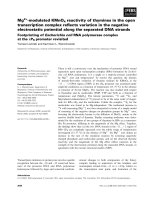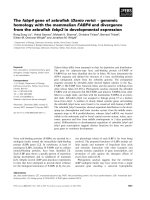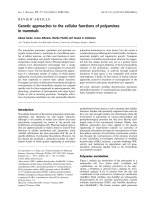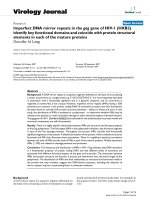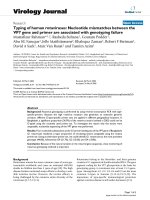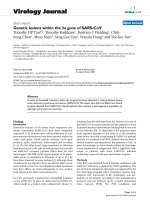Genetic variation in the VP7 gene of rot
Bạn đang xem bản rút gọn của tài liệu. Xem và tải ngay bản đầy đủ của tài liệu tại đây (1.15 MB, 7 trang )
Virus Research 165 (2012) 190–196
Contents lists available at SciVerse ScienceDirect
Virus Research
journal homepage: www.elsevier.com/locate/virusres
Genetic variation in the VP7 gene of rotavirus G1P[8] strains isolated in Vietnam,
1998–2009
Nguyen Van Trang a , Tetsu Yamashiro b,c , Le Thi Kim Anh a , Vu Thi Bich Hau a , Le Thi Luan d ,
Dang Duc Anh a,∗
a
The National Institute of Hygiene and Epidemiology, Ha Noi, Viet Nam
Center for Infectious Disease Research in Asia and Africa, Institute of Tropical Medicine, Nagasaki University, Japan
c
Vietnam Research Station, Japan Initiative for Global Research Network on Infectious Diseases (J-GRID), Ha Noi, Viet Nam
d
Center for Research and Production of Vaccines and Biologicals, Ha Noi, Viet Nam
b
a r t i c l e
i n f o
Article history:
Received 17 October 2011
Received in revised form 7 February 2012
Accepted 16 February 2012
Available online 25 February 2012
Keywords:
Rotavirus
G1P[8]
VP7
Genetic variation
Vietnam
a b s t r a c t
Group A rotavirus genotype G1P[8] is the most common strain affecting humans around the world over
the past few decades. In this study, we examined genetic variation in the VP7 gene of rotavirus G1P[8]
strains, detected in children of four major cities of Vietnam during three different rotavirus seasons:
1998–1999, 2007–2008 and 2008–2009 in order to assess the evolution of the virus over 11 years. Fecal
samples (n = 73) from children hospitalized for gastroenteritis caused by G1P[8] rotavirus were analyzed
by DNA sequencing of gene 9 encoding the VP7 capsid protein. Phylogenetic analyses indicated that VP7
gene of the G1 strains from 1999 contained a lineage I, while rotaviruses from 2009 clustered in lineage
II. Both of these lineages were found co-circulating in 2007–2008 season. While different sublineages
of lineage I and II co-circulated in the 1998–1999 and 2007–2008 seasons, almost all strains in 2009
belonged to sub-lineage II-C. In the analysis using selected 10 strains, the VP4 genes of these 2 VP7-G1
lineages were all grouped in F45-like cluster. Deduced amino acid analyses indicated that there were
thirteen amino acid substitutions between strains of two lineages. Of those, two were found in antigenic
regions A and C, implying possible antigenic differences between these two lineages. The G1P[8] strains
in Vietnam are very genetically diverse and dynamic, implying the frequent monitoring on evolution of
rotavirus will be important to assess efficacy of rotavirus vaccine in Vietnam.
© 2012 Elsevier B.V. All rights reserved.
1. Introduction
Rotavirus is the most important cause of acute gastroenteritis
(AGE) in children worldwide. In Vietnam, rotavirus is responsible for more than 50% of AGE cases in hospitalized children (Van
Man et al., 2005). Rotaviruses which form a genus of the Reoviridae family, are non-enveloped virus with 11 segments of double
stranded RNA as their genome. The VP4 and VP7 proteins of the
outer capsid encoded by gene segments 4 and 9, respectively, are
important neutralizing antigens and define independent G and P
serotype specificities (Kapikian et al., 2001). There are now 27 G
and 35 P types described in human and animals (Matthijnssens
et al., 2011). Much like cases of influenza virus, seasonal shifts of
group A rotavirus strains have been contributing to the persistence
of the virus in a human population (Parra, 2009). In addition, genetic
drift is implied by the presence and emergence of different lineages
∗ Corresponding author at: The National Institute of Hygiene and Epidemiology,
No. 1 Yersin Street, Ha Noi, Viet Nam. Tel.: +84 43 971 2989; fax: +84 43 821 2660.
E-mail address: (D.D. Anh).
0168-1702/$ – see front matter © 2012 Elsevier B.V. All rights reserved.
doi:10.1016/j.virusres.2012.02.015
within a genotype. Almost all genotypes have different lineages,
genotype G9 has at least 3 lineages (Hoshino et al., 2004), genotype
G2 has at least 4 lineages, genotype G4 has 2 lineages and several
sublineages (Trinh et al., 2010).
Genotype G1P[8] has been reported as the most common
rotavirus strain circulating around the world, accounting for 53% of
all rotavirus genotypes (Gentsch et al., 2005; Santos and Hoshino,
2005). The diversity within genotype G1 is great; 11 different lineages and 17 sublineages have been described (Phan et al., 2007).
Phan et al. proposed an identification method based on signature
codes consisted of 14 amino acids at positions 29, 34, 35, 37, 42, 43,
50, 55, 57, 65, 68, 72, 74 and 75 in the VP7 region of G1 rotavirus
that define phylogenetic lineages and sub-lineages of the G1 genotype. The code for lineage I is IIYFVAALITSQ(R)G(E)V, for lineage III
is IIYFVAALLATQEV and for lineage XI is MIYFVTAILTAKET. Further
modifications in this code identified sublineages of G1 rotavirus.
In this study we used this identification code to study changes in
genotype G1 lineages of strains from different regions in Vietnam.
In Vietnam, G1[8] had been the dominant strain until 2005 with
a prevalence of 58.3% (Van Man et al., 2005). After a brief period of
the dominance with G3 rotavirus in 2006–2009 (Ngo et al., 2009),
N.V. Trang et al. / Virus Research 165 (2012) 190–196
Table 1
Number of rotavirus analyzed in this study.
Site of sample collection
Season
1998–1999a
North of Vietnam
Hanoi
Haiphong
South of Vietnam
Nha Trang
Ho Chi Minh city
Total
2007–2008a
4
6
7
7
5
4
19
4
10
28
2008–2009a
9
b
NA
10
7
26
a
The total numbers of G1P[8] strains detected in 2007–2008 and 2008–2009 seasons were 181 and 256 samples, respectively. Genotypings were not performed in
all samples of 1998–1999 season, so the total number of G1P[8] strains in this season
was not determined.
b
NA: samples not collected in this site at this time point.
G1P[8] strains returned in 2010 (Nguyen Van Trang et al., unpublished data). One G1P[8] strain has been chosen as the candidate
for vaccine in Vietnam, even though the diversity of the G1P[8]
rotavirus has not been well studied. Considering the large genetic
diversity of G1P[8] rotavirus in particular, it raises a concern that
accumulation of point mutations in antigenic regions of VP7 and
VP4 gene could result in rotavirus strains that are less effective by
vaccine induced neutralizing antibodies and overtime would result
in predominance of rotavirus strains which are less effected by or
even resistant to the vaccine (Matthijnssens et al., 2009). Among
the 3 lineages of G9P[8], it is recommended that lineage 1 should
be included in the vaccine since antisera developed to this lineage
could neutralize the other 2 lineages efficiently whereas antisera to
either lineage 2 and 3 could not neutralize other lineages efficiently
(Hoshino et al., 2004). In this study, we examined mutations in gene
9 (VP7) of G1P[8] strains isolated in four major cities of Vietnam in
three different periods between 1999 and 2009 in order to monitor
evolution of viruses circulating in Vietnam. The results of this study
have implications for vaccine development and strategy and suggest a need for a continuous surveillance for this strain, especially
after vaccine introduction.
2. Materials and methods
2.1. Samples
We analyzed the fecal samples collected from children under
5 years hospitalized for acute gastroenteritis. These samples
were collected in previous studies in 1998–1999, 2007–2008 and
2008–2009 seasons (Ngo et al., 2009; Nguyen et al., 2001). These
samples have been stored at −20 ◦ C or −80 ◦ C. The locations where
the samples tested positive for rotavirus were collected and the
time period are summarized in Table 1. For each study site and
each season, up to 10 samples were randomly selected among the
G1P[8] positive samples for sequencing analysis of the VP7 gene.
All samples were delinked from patient identifiers and only the
site and date of collection were maintained. The rotavirus positive
samples were genotyped as G1P[8] by nested RT-PCR following
by sequencing of gene 9. The samples were collected from the
National Pediatric Hospital in Ha Noi (20 samples), Children’s Hospital No. 1 in Ho Chi Minh City (21 samples), Khanh Hoa General
Hospital in Nha Trang city (19 samples) and Children’s Hospital in
Hai Phong city (13 samples) during the years 1999–2009 in the
rotavirus surveillance programs (Table 1).
191
RNA mini kit (Qiagen, GmbH, Germany), following manufacturer’s
manual, aliquoted and stored at −80 ◦ C. The reverse transcription
reaction was performed using primer pair 9con1 and VP7R (Gouvea
et al., 1990). The sequencing of the 897 bp amplicon was performed
using an automated sequencing system (Genetic Analyzer 3130,
Applied Biosystems, Inc., Foster City, CA). The comparison analysis
was conducted on the G1 strains analyzed in the study and other
G1 reference strains available in GenBank.
Ten samples representing the G1-VP7 sublineages in each region
and period (1 sample/site/season) were selected for sequencing of
876 bp amplicons of the VP4 gene using con2 and con3 primers
(Gentsch et al., 1992). The comparison analysis was conducted on
the P[8] strains analyzed and other P[8] reference strains available
in GenBank.
The sequence data and the phylogenetic analysis were carried
out using BioEdit v7.0.5. Parsimony analysis was also conducted
using MEGA version 5.0 to determine the evolutionary relationship (Tamura et al., 2007) among sequences studied. The method
was performed using neighbor-joining with a random option and
500 bootstrap repetitions. The bootstrap value of ≥50 is presented.
Calculation of the accumulated mutation rate of VP7 gene in Vietnam over 11 years was made. Sequence comparisons of the VP7
and VP4 genes investigated and those of G1 and P[8] reference
strains available in GenBank were carried out. The amino acid substitutions of the portion of the VP7 segment (amino acid positions
0–263) (nu 95–762) were counted and the annually accumulated
mutation rate per site was calculated. The VP4 and VP7 sequences
of the Vietnamese strains analyzed in this study were submitted to GenBank with accession number JF690673–JF690745 and
JN790709–JN790718.
Reference VP7 sequences of G1 rotavirus strains and accession
numbers used in this study are the following: strain Fin-408, accession no. Z80303; Oh-64, U26387; Fin-431, Z80314; Cos70, U26370;
Fin-111–1, Z80278; Au81, M64666; PA5-03, DQ377596; PA2-04,
DQ377598; PA5, Q377573; PA164, DQ377588; ISO-4, AY098670;
PA430, DQ377591; Thai-1604, DQ512981; PA378, DQ377589;
Dhaka8, AY631049; Fin-429, Z80312; VN-281, DQ508167;
Au007, AB081799; VN-355, DQ512968; Fin-101–1, Z80271;
Thai-804, DQ512979; Fin-425-1, Z80309; Mvd9816, AF480293;
G192B, AF043678; Mvd9810, AF480288; DC03, AF183850; 97′ S6,
AF260945; CH631, AF183857; China-45, U26371; JP471, D16328;
JPTE1, D17721; Wa, K02033; Egypt-8, U26374; HOU8697, U88717;
JP-6916, EF079067; JP-7108, EF079068; JP-7014, EF079064;
JP-7124, EF079069; JP-7206, EF079065; JP-7154, EF079070;
Accession number of the VP7 sequence of USA/DS1/1976 (G2) is
EF672581.
Reference VP4 sequences of P[8] rotavirus strains and accession
numbers used in this study are the following: RVA/Humanwt/KOR/CAU-202,
EF059923;
KOR/CAU-219,
EU679394;
THA/CU90P8, DQ235978; JPN/F45, U30716; MAL/OP354,
AJ302148; CHN/WH-624, AY856444; MAL/MW670, AJ302146;
IND/RMC437, AY603158; IND/Sc134 AJ293720; USA/Wa, M21843;
CHN/WH-1194, AY85644; HUN/BP1829, AJ605319; JPN/Odelia,
AB008296; THA/CU20, DQ235973; IND/ISO43, DQ355959.
Accession number of the VP4 sequence of USA/DS1 (P[4]) is
AB118025.
3. Results
3.1. Analyses of VP7 genes from G1P[8] strains collected during
1998 and 2009
2.2. Sequencing of VP7 and VP4 regions
Fecal samples were diluted in DEPC-treated water to make 20%
suspension and the viral RNA was extracted using the Qiagen viral
The VP7 genes of 73 G1P[8] rotavirus strains were sequenced
and phylogenetic analysis was performed. G1P[8] strains were
obtained from each of the four cities (Ha Noi, Ho Chi Minh city, Hai
192
N.V. Trang et al. / Virus Research 165 (2012) 190–196
IB
IA
ID
IC
IE
IIE
IIA
IID
IIB
IIC
Fig. 1. Phylogenetic tree obtained from nucleotide sequence analyses on VP7 genes of G1 rotavirus isolated in Vietnam during 1998–1999 (in thin-line boxes), 2007–2008 (in
thick-line boxes) and 2008–2009 (in dashed-line boxes) seasons. Selected strains from different cities and rotavirus seasons within each G1-sublineage are depicted in this
figure. Reference strains were selected from GenBank (The GenBank accession numbers of reference strains and the Vietnamese strains identified in this study are indicated
at the end of Section 2). Abbreviations of sites where the strains were isolated are as follows: HCMC, Ho Chi Minh city; HNI, Ha Noi; KH; Khanh Hoa and HP, Hai Phong.
N.V. Trang et al. / Virus Research 165 (2012) 190–196
193
Fig. 2. Phylogenetic tree obtained from nucleotide sequence analyses on VP4 genes of P[8] rotavirus isolated in Vietnam (in boxes). Reference strains were selected from
GenBank (The GenBank accession numbers of reference strains and the Vietnamese strains identified in this study are indicated at the end of Section 2). Abbreviations of
sites where the strains were isolated are the same as Fig. 1.
Phong and Nha Trang) in the 1998–1999 and 2007–2008 seasons.
During the 1998–1999 (19 strains) and 2007–2008 (28 strains) seasons isolates were obtained from each of the four cities (Ha Noi,
Ho Chi Minh city, Hai Phong and Nha Trang), while in 2008–2009
season isolates were obtained from all cities except Hai Phong
(Table 1).
All of the Vietnamese G1 strains analyzed in the study belonged
to either lineage I or II. Among the G1P[8] strains detected in the
1998–1999 season, lineages I (sublineages B, C, D and E) were identified in all 4 cities and no lineage II strains were found (Fig. 1). In
2008–2009 season, however, the majority of strains detected in all
cities where samples were collected belonged to lineage IIC and
only 1 isolate of lineage I (D) was found (Fig. 1). In 2007–2008 season in contrast, either lineage I (IB, ID, IE) or lineage II (IIC and IIE)
G1 rotavirus were detected in all 4 cities (Fig. 1). Thus, it is likely
that G1 strain circulating in Vietnam was changed from lineage
I to II in the period between 1998 and 2009, particularly in the
2007–2008 season. The lineage II (C) G1 rotaviruses detected in the
2008–2009 rotavirus season were highly homologous to each other
in amino acid sequence irrespective of the site where the sample
was collected (Fig. 1). The VP4 genes of the selected 10 out of 73
G1P[8] strains (representing different G1-VP7 sublineages, different cities and rotavirus seasons) were analyzed and all grouped
in F45-like cluster (Fig. 2). Of note, the vaccine candidate strain
Rotavin-M1 that was isolated in Nha Trang city in 2003, belongs to
lineage I. Rotarix (GSK) belongs to lineage II and the G1 strains of
RotaTeq belong to lineage III, similar to Wa strain (Luan le et al.,
2009; Matthijnssens et al., 2010b; Richardson et al., 1984).
3.2. Deduced amino acid differences between the VP7 proteins of
lineage I and lineage II strains of G1 rotavirus
The drift from lineage I to II was accompanied by amino acid
substitutions at 13 positions including I29M, F37S, K49R, L55I,
I57L, T65A, V66A, S68A, S94N, T108I, N123S, T217M, and I268V.
Applying the identification code system for different lineages proposed by Phan et al. for amino acid position 29–75, lineage I can be
described as IIYFVAALITSQGV and lineage II as MIYSVAAILAAQGI.
Conserved amino acid substitutions between lineages I and II, were
also observed at other sites which were not part of Phan’s identification code including S94N, T108N, N123S, T217M and I268V. In
addition, one change each was identified in antigenic region A (at
position 94) and C (position 217) of the protein, respectively (Fig. 3)
between lineage I and II strains. In antigenic region B, the change
S147N has been observed in several lineage I and II strains, but not in
lineage III isolates (RotaTeq GI and Wa). Two amino acid differences
194
N.V. Trang et al. / Virus Research 165 (2012) 190–196
Fig. 3. Amino acid substitutions in the VP7 protein that are observed between lineages I and II. Antigenic regions (A, B, C) are indicated. Selected strains from different cities
and rotavirus seasons within each sublineage are depicted in this figure. Abbreviations of sites where the strains were isolated are the same as Fig. 1. The GenBank accession
numbers of reference strains and the Vietnamese strains identified in this study are indicated at the end of Section 2.
between lineages I and II (V66A and I268V) that occurred during the
time period 1998–2008 were maintained through the 2008–2009
season. In contrast, only a single conserved amino acid substitution
occurred in the VP7 protein of lineage II strains from 2007 to 2009,
at position 41 (F41S). Some virus strains from Ha Noi, Hai Phong
and Ho Chi Minh City have a change at position 91 (T91N) that has
also been observed for strains in Japan and China. Strains in Hai
Phong from 2007 exhibit S at position 147 instead of N which was
previously thought to be the signature for all G1 lineages except
III. Similarly, E but not D is common for all Vietnamese strains at
position 97.
The difference in amino acid sequence within lineage I strains
from 1998 to 1999 and 2007 to 2008 seasons ranged from 0%
to 3.6%, depending on study sites, whereas the difference in
amino acid sequence of the protein between 2007–2008 and
2008–2009 seasons is smaller (0–0.8%). The amino acid difference between lineages I and II in different study sites ranged
from 4.9% to 6.1% between 1998–1999 and 2008–2009. Based on
the 13 amino acid changes over the 11 year period among the
total 263 amino acid residues consisting 5 antigenic sites of this
protein available for analysis, we approximated the rate of accumulation of amino acid substitutions to be 0.9 × 10−3 /site/year.
Similarly, based on the 46 nucleotide changes over the 11 year
period among the total 668 nucleotides of the gene under analysis,
the rate of accumulation of nucleotide substitutions is estimated as
1.3 × 10−3 /site/year.
4. Discussion
Rotavirus strain G1P[8] has been a globally dominant strain for
more than 30 years and a number of studies have documented
the great genetic variability of this genotype. A study in Italy for
strains collected over 19 years indicated the continuing appearance of rotavirus G1 variants (Arista et al., 2006). In the Italian
study, Arista et al. identified 7 G1 lineages while Phan et al. classified this genotype into 11 lineages based on the representative
G1 strain sequences available worldwide (Arista et al., 2006; Phan
et al., 2007). A study from Hungary also showed that G1 sublineages changed 6 times over a 16 year period, suggesting that
antigenic drifts occur periodically (Banyai et al., 2009). However,
the study from Hungary also identified co-existence of lineages
I and II in most seasons. In the current study, we found that
the G1P[8] strains circulating in Vietnam were diverse during
the period 1998–1999 to 2007–2008, but were more conserved
in 2008–2009. In 2008–2009, there was a drift from lineage I to
II G1P[8] of the VP7 gene in Vietnam, while all the VP4 gene
N.V. Trang et al. / Virus Research 165 (2012) 190–196
grouped in F45-like cluster. The ability to observe such drifts in
predominant strain lineages is possible only through long term
surveillance, in this case over an 11 year time period. In addition,
because we conducted surveillance in 4 different sites across the
countries throughout this period, we were able to document that
the drift in the predominant G1 lineage occurred throughout Vietnam.
Other studies conducted for shorter periods have not always
observed distinct G1 lineages. A study from Western India for 2
time points from 1991 to 1994 and 2006 showed that lineage I was
predominant at both time points (Arora et al., 2009). The G1 strain
in the 3 major cities of Australia in 1996 was extremely homogenous, with >99% nucleotide identity and >98.3% amino acid identity
(Jayasinghe and Palombo, 1999). A study by Trinh et al. showed that
the G1 strain detected in Vietnam, Japan, China and Thailand during 2002–2005 fell into a single lineage (Trinh et al., 2007). Le et al.
found that the G1 detected in Korea during 2004–2006 belonged to
lineage I (Le et al., 2010). Thus, the epidemiology of G1 strains is different depending on how long the sampling period is, the regions
where the samples are collected.
It remains to be proven whether the genetic differences between
lineages translate into antigenic differences. In children vaccinated
with a rotavirus vaccine who exhibited diarrhea due to Rotavirus,
G1 strains were isolated which were different from the vaccine
strains. This observation suggests that the vaccines failed to provide protection against virus of different lineages (Matthijnssens
et al., 2009). However, it remains to be seen whether all G1 vaccine failures will be due to strains in different G1 lineage from
the vaccine strain. Rotarix was developed from the 89–12 strain
(isolated in 1989) belonging to lineage II the same lineage as
most of the Vietnamese strains of 2009, but in a different lineage
from those detected during 1998–1999. Lineage III of Wa and the
RotaTeq G1 was not found in Vietnam during the years we surveyed (Matthijnssens et al., 2010b). However, among the 3 G9P[8]
lineages, lineage I is preferred over other 2 lineages when including
in the vaccine (Hoshino et al., 2004). Thus it is important to continue
monitoring both genetic and antigenic difference between lineages
of the same virus genotypes.
It is interesting to note that the strains became homogenous
in 2008–2009 with all strains belonging to lineage IIC whereas in
previous years, different sublineages of lineages I and II co-existed.
The reason for this strain convergence and switching is unknown.
In our study, the 14 amino acid identification code proposed
by Phan et al. for different VP7-G1 lineages is maintained. However, we identified substitutions at other sites beyond this region
(amino acid 29–75) and an additional substitution at amino acid
66 that could be used to differentiate between lineages I and II.
We also identified a change within lineage II (F41S) which has
not previously been documented. Strains detected in 2007 all
have a T91N substitution as previously found only in China and
Japan (Trinh et al., 2007). With the geographical proximity of Vietnam to China, and their active social and economical interactions
prompted the virus movement across the countries. Arora et al.
also documented several changes in this signature code for sublineage IB and IIB (Arora et al., 2009). Therefore it is suggested that
the Phan’s identification code could be used as minimum requirement for distinguishing strains of different lineages and occasional
updates using a larger numbers of strains from different time periods should be done.
Changes in nucleotide sequence are more significant when
there is a corresponding amino acid substitution in the antigenic
region. For VP7, there are 5 antigenic sites designated A (amino
acid 87–101), B (amino acid 142–152), C (amino acid 208–221),
D (amino acid 291) and F (amino acid 232–242) (Hoshino et al.,
1994). We observed amino acid sequence differences between G1
lineages I and II in antigenic sites A and C, suggesting there might be
195
a corresponding change in antigenicity. The signature amino acid
N at position 147 (antigenic region B) for all lineages except lineage III does not apply to some of strains from Hai Phong. Analysis
using specific monoclonal antibodies to each of these sites could
be one approach to study this hypothesis. Even though information on the substitution rates for VP7 gene in Vietnam could not be
found in previous studies, the rates of nucleotide and consequent
deduced amino acid substitutions in VP7 region of G1 rotavirus are
calculated as 0.9 × 10−3 /site/year and 1.3 × 10−3 /site/year, respectively, which are similar to those observed in a previous study
(Matthijnssens et al., 2010a).
In this study, we investigated changes in VP7 and VP4 genes.
However, it is necessary to monitor overall mutations dispersed
across all 11 segments to identify global changes in the virus
genome (Matthijnssens et al., 2008). These studies are valuable for
assessment of vaccine and to see whether a novel strain will emerge
and become predominant having evaded immunity provided by the
vaccine.
Conflicts of interest
None.
Acknowledgments
The study was partly sponsored by the National Foundation
for Science and Technology Development-Vietnam (PI Dang Duc
Anh, project number 106.99.182.09) and Japan Initiative for Global
Research Network on Infectious Diseases (J-GRID) for the sample
collection and the sequencing analyses.
The portion of stool collection was funded by the World Health
Organization (for the rotavirus surveillance program from 1998
to 2009 of N. Van Man and L.T. Luan). We sincerely thank Drs
Anne-Lise Haenni (University of Paris), James Jones (Henry Jackson Foundation) and Jon R. Gentsch (US-CDC) for critical reading of
the manuscript.
References
Arista, S., Giammanco, G.M., De Grazia, S., Ramirez, S., Lo Biundo, C., Colomba, C.,
Cascio, A., Martella, V., 2006. Heterogeneity and temporal dynamics of evolution
of G1 human rotaviruses in a settled population. J. Virol. 80 (21), 10724–10733.
Arora, R., Chhabra, P., Chitambar, S.D., 2009. Genetic diversity of genotype G1
rotaviruses co-circulating in western India. Virus Res. 146 (1-2), 36–40.
Banyai, K., Gentsch, J.R., Martella, V., Bogdan, A., Havasi, V., Kisfali, P., Szabo, A.,
Mihaly, I., Molnar, P., Melegh, B., Szucs, G., 2009. Trends in the epidemiology
of human G1P[8] rotaviruses: a Hungarian study. J. Infect. Dis. 200 (Suppl. 1),
S222L 227.
Gentsch, J.R., Glass, R.I., Woods, P., Gouvea, V., Gorziglia, M., Flores, J., Das, B.K., Bhan,
M.K., 1992. Identification of group A rotavirus gene 4 types by polymerase chain
reaction. J. Clin. Microbiol. 30 (6), 1365–1373.
Gentsch, J.R., Laird, A.R., Bielfelt, B., Griffin, D.D., Banyai, K., Ramachandran, M., Jain,
V., Cunliffe, N.A., Nakagomi, O., Kirkwood, C.D., Fischer, T.K., Parashar, U.D., Bresee, J.S., Jiang, B., Glass, R.I., 2005. Serotype diversity and reassortment between
human and animal rotavirus strains: implications for rotavirus vaccine programs. J. Infect. Dis. 192 (Suppl. 1), S146L 159.
Gouvea, V., Glass, R.I., Woods, P., Taniguchi, K., Clark, H.F., Forrester, B., Fang, Z.Y.,
1990. Polymerase chain reaction amplification and typing of rotavirus nucleic
acid from stool specimens. J. Clin. Microbiol. 28 (2), 276–282.
Hoshino, Y., Jones, R.W., Ross, J., Honma, S., Santos, N., Gentsch, J.R., Kapikian,
A.Z., 2004. Rotavirus serotype G9 strains belonging to VP7 gene phylogenetic
sequence lineage 1 may be more suitable for serotype G9 vaccine candidates
than those belonging to lineage 2 or 3. J. Virol. 78 (14), 7795–7802.
Hoshino, Y., Nishikawa, K., Benfield, D.A., Gorziglia, M., 1994. Mapping of antigenic
sites involved in serotype-cross-reactive neutralization on group A rotavirus
outercapsid glycoprotein VP7. Virology 199 (1), 233–237.
Jayasinghe, S.M., Palombo, E.A., 1999. Genetic homogeneity of human serotype G1
rotaviruses isolated during a single epidemic season: implications for vaccine
strategies. Acta Virol. 43 (1), 53–55.
Kapikian, A.Z., Hoshino, Y., Chanock, R.M., 2001. Rotaviruses. In: Knipe, D.M., Howley, P.M. (Eds.), Fields Virology, vol. 1. 2 vols. Lippincott Williams & Wilkins,
Philadelphia, pp. 1787–1833.
196
N.V. Trang et al. / Virus Research 165 (2012) 190–196
Le, V.P., Chung, Y.C., Kim, K., Chung, S.I., Lim, I., Kim, W., 2010. Genetic variation
of prevalent G1P[8] human rotaviruses in South Korea. J. Med. Virol. 82 (5),
886–896.
Luan le, T., Trang, N.V., Phuong, N.M., Nguyen, H.T., Ngo, H.T., Tran, H.B., Dang, H.N.,
Dang, A.D., Gentsch, J.R., Wang, Y., Esona, M.D., Glass, R.I., Steele, A.D., Kilgore,
P.E., Nguyen, M.V., Jiang, B., Nguyen, H.D., 2009. Development and characterization of candidate rotavirus vaccine strains derived from children with diarrhoea
in Vietnam. Vaccine 27 (Suppl. 5), F130L 138.
Matthijnssens, J., Bilcke, J., Ciarlet, M., Martella, V., Banyai, K., Rahman, M., Zeller, M.,
Beutels, P., Van Damme, P., Van Ranst, M., 2009. Rotavirus disease and vaccination: impact on genotype diversity. Future Microbiol. 4 (10), 1303–1316.
Matthijnssens, J., Ciarlet, M., McDonald, S.M., Attoui, H., Banyai, K., Brister, J.R., Buesa,
J., Esona, M.D., Estes, M.K., Gentsch, J.R., Iturriza-Gomara, M., Johne, R., Kirkwood,
C.D., Martella, V., Mertens, P.P., Nakagomi, O., Parreno, V., Rahman, M., Ruggeri,
F.M., Saif, L.J., Santos, N., Steyer, A., Taniguchi, K., Patton, J.T., Desselberger, U.,
Van Ranst, M., 2011. Uniformity of rotavirus strain nomenclature proposed by
the Rotavirus Classification Working Group (RCWG). Arch. Virol.
Matthijnssens, J., Ciarlet, M., Rahman, M., Attoui, H., Banyai, K., Estes, M.K., Gentsch,
J.R., Iturriza-Gomara, M., Kirkwood, C.D., Martella, V., Mertens, P.P., Nakagomi,
O., Patton, J.T., Ruggeri, F.M., Saif, L.J., Santos, N., Steyer, A., Taniguchi, K., Desselberger, U., Van Ranst, M., 2008. Recommendations for the classification of
group A rotaviruses using all 11 genomic RNA segments. Arch. Virol. 153 (8),
1621–1629.
Matthijnssens, J., Heylen, E., Zeller, M., Rahman, M., Lemey, P., Van Ranst, M., 2010a.
Phylodynamic analyses of rotavirus genotypes G9 and G12 underscore their
potential for swift global spread. Mol. Biol. Evol. 27 (10), 2431–2436.
Matthijnssens, J., Joelsson, D.B., Warakomski, D.J., Zhou, T., Mathis, P.K., van Maanen,
M.H., Ranheim, T.S., Ciarlet, M., 2010b. Molecular and biological characterization of the 5 human-bovine rotavirus (WC3)-based reassortant strains of the
pentavalent rotavirus vaccine, RotaTeq. Virology 403 (2), 111–127.
Ngo, T.C., Nguyen, B.M., Dang, D.A., Nguyen, H.T., Nguyen, T.T., Tran, V.N., Vu, T.T.,
Ogino, M., Alam, M.M., Nakagomi, T., Nakagomi, O., Yamashiro, T., 2009. Molecular epidemiology of rotavirus diarrhoea among children in Haiphong, Vietnam:
the emergence of G3 rotavirus. Vaccine 27 (Suppl. 5), F75–F80.
Nguyen, V.M., Nguyen, V.T., Huynh, P.L., Dang, D.T., Nguyen, T.H., Phan, V.T., Nguyen,
T.L., Le, T.L., Ivanoff, B., Gentsch, J.R., Glass, R.I., 2001. The epidemiology and
disease burden of rotavirus in Vietnam: sentinel surveillance at 6 hospitals. J.
Infect. Dis. 183 (12), 1707–1712.
Parra, G.I., 2009. Seasonal shifts of group A rotavirus strains as a possible mechanism
of persistence in the human population. J. Med. Virol. 81 (3), 568–571.
Phan, T.G., Khamrin, P., Quang, T.D., Dey, S.K., Takanashi, S., Okitsu, S., Maneekarn, N.,
Ushijima, H., 2007. Detection and genetic characterization of group A rotavirus
strains circulating among children with acute gastroenteritis in Japan. J. Virol.
81 (9), 4645–4653.
Richardson, M.A., Iwamoto, A., Ikegami, N., Nomoto, A., Furuichi, Y., 1984. Nucleotide
sequence of the gene encoding the serotype-specific antigen of human (Wa)
rotavirus: comparison with the homologous genes from simian SA11 and UK
bovine rotaviruses. J. Virol. 51 (3), 860–862.
Santos, N., Hoshino, Y., 2005. Global distribution of rotavirus serotypes/genotypes
and its implication for the development and implementation of an effective
rotavirus vaccine. Rev. Med. Virol. 15 (1), 29–56.
Tamura, K., Dudley, J., Nei, M., Kumar, S., 2007. MEGA4: Molecular Evolutionary Genetics Analysis (MEGA) software version 4.0. Mol. Biol. Evol. 24 (8),
1596–1599.
Trinh, Q.D., Nguyen, T.A., Phan, T.G., Khamrin, P., Yan, H., Hoang, P.L., Maneekarn,
N., Li, Y., Yagyu, F., Okitsu, S., Ushijima, H., 2007. Sequence analysis of the VP7
gene of human rotavirus G1 isolated in Japan, China, Thailand, and Vietnam in
the context of changing distribution of rotavirus G-types. J. Med. Virol. 79 (7),
1009–1016.
Trinh, Q.D., Pham, N.T., Nguyen, T.A., Phan, T.G., Yan, H., Hoang le, P., Khamrin, P., Maneekarn, N., Li, Y., Okitsu, S., Mizuguchi, M., Ushijima, H., 2010.
Sequence analysis of the VP7 gene of human rotaviruses G2 and G4 isolated
in Japan, China, Thailand, and Vietnam during 2001–2003. J. Med. Virol. 82 (5),
878–885.
Van Man, N., Luan le, T., Trach, D.D., Thanh, N.T., Van Tu, P., Long, N.T., Anh, D.D.,
Fischer, T.K., Ivanoff, B., Gentsch, J.R., Glass, R.I., 2005. Epidemiological profile and
burden of rotavirus diarrhea in Vietnam: 5 years of sentinel hospital surveillance,
1998–2003. J. Infect. Dis. 192 (Suppl. 1), S127–S132.



